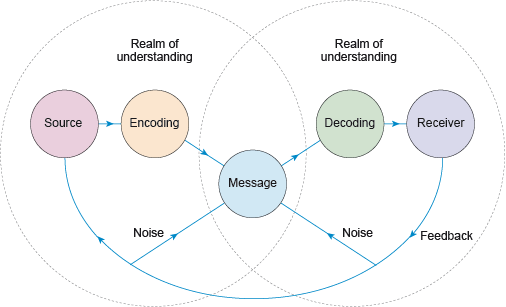3.2 The linear model of communication
All businesses need to engage the attention of their customers and marketing communications are the mechanism that facilitates this process. Retailers plan communication campaigns seeking to inform, persuade, build relationships and create interest from specific target customers.
In its simplest form, communication is a two-way exchange between two parties.

The linear communication model

According to Fill (2009, p. 42, quoting Theodorson and Theodorson, 1969) this is a linear model that emphasises the ‘transmission of information, ideas, attitudes, or emotion from one person to another, primarily through symbols’. The model and its components are straightforward but it is the quality of the linkages between the various elements in the process that determine whether a communication event will be successful.
In other words, does the message sender (source) use the right language and images (encoding) to create a message, which can be interpreted (decoded) by the message recipient (receiver)? Successful messages need to be heard over and above interruptions (noise) and ultimately the realms of understanding of the message sender and the message receiver should overlap.
Retail marketing communications rely, to a large extent, on these principles of communication being successfully implemented.
Activity 7: What is noise?
Purpose: to consider how communication messages can be interrupted.
Noise is a factor that interferes with the communication process. Noise distorts the message and means you may only receive part of the story. There is always a potential for noise to interfere with the communication process. Therefore, marketing communications management should aim to produce communications which keep noise levels to a minimum.
Let’s identify some types of noises that could interrupt the delivery of a communication message.
Task: Listen to the following podcasts, identify each sound and then explain how each of the noises might interrupt the communication process, while you are watching a television advert.
Transcript: Sound 2
Female:
In our school.
Male:
Well, how, how many have you got in your school then?
Female:
Well they’re varying from about, I don’t know 30. I think the worse case er next year we’re looking at may be 38.
Male:
38?
Female:
Yeah.
Male:
That’s ridiculous.
Female:
Yeah I know.
Male:
How come you’ve got 38? You’re stupid.
Female 2:
Excuse me do you mind turning it down please I’m trying to listen to something.
Female:
Oh sorry about that.
Male:
Sorry.
Answer
Actual sounds:
- the telephone ringing distracts your attention, causes a break in concentration and may require you to move away to another location to have a more private conversation
- the noise of passing traffic, a vacuum cleaner or people coughing can all distract your attention, interfere with your hearing of the message or stop you receiving the whole of the message in the television advert
- people talking and asking questions can distract your attention. Competing messages from individuals can lead to commercial messages being screened out completely.
Activity 8: Other types of noise
Purpose: to identify different types of noise.
Task: Now look at the images of other types of distractions. Again, explain how the interruption might affect the communication process.

Answer
Picture 1 this is a physical disturbance which can block out part of the message. The individual looking at the message is likely to only see part of the message.
Picture 2 this is an example of a physical and a cognitive disturbance. A pet physically distracts the message recipient but the recipient will also begin thinking about the distraction.
Picture 3 this is an example of cognitive noise. The message recipient does not understand the message. The language is difficult for the message recipient to understand and therefore they are not able to decode the message completely. In other words, the realms of understanding in this situation do not overlap sufficiently.
It is important to note that noise can be created by physical factors, like actual sounds and individual behaviour, but also cognitive factors. Cognitive distractions tend to be abstract and are things that interfere with our perceptions and interpretations of messages. A cognitive distraction might occur if the encoding of the message was inappropriate so the receiver found the message difficult to understand, e.g. a message that is garbled or uses language that is too complex. Retailers need to ensure when they send communication messages that the target for the message has the greatest opportunity to receive the message. This can be achieved by tailoring the message and careful planning of when and how the message will be received and the media that will carry the message.
